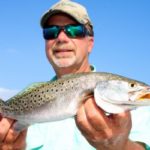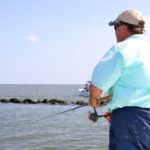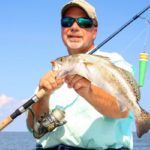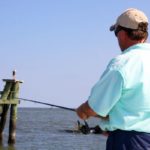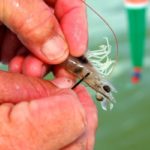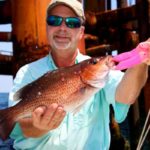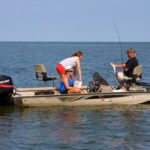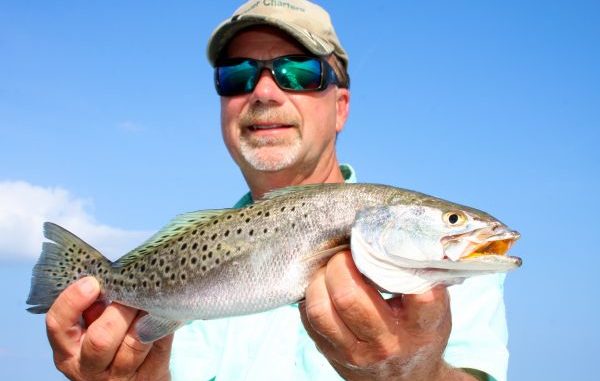
There’s always something biting out of Grand Isle. All you have to do is get there and have an open mind.
It was time to put Plan B into action.
Craig Matherne and I had been trying to coax a trout or two to bite on the surf side of Grand Isle, and we were having very little luck.
All the while we hauled water, the nearshore rigs behind us loomed large in the mind of the captain, who operates Premiere Charters of Grand Isle.
“You’re in here fishing the surf, and all you can think about are the rigs,” he chuckled. “And then you get out there fishing the rigs, and all you can think about is fishing the surf.”
The good thing for us and every other angler who fishes Grand Isle is that the two aren’t so far apart that we had to commit to only one.
Within a 10-mile band of water, you can catch trout on the beach or mangrove snapper on the rigs.
Although I don’t know of many anglers who would bounce back and forth between the two all day long, the proximity of the trout and mangroves means if one isn’t biting you can always go check the other.
As we idled out from Bridge Side Marina earlier that morning, Matherne noted that the recent summer weather had been just a little bit goofy.
“We’ve had a mixture of fronts, rain for four or five days in a row and wind from so many different directions that it’s actually kicked everything up,” Matherne said. “And yesterday the water looked almost sand-colored.”
Our trip that had been planned for weeks in advance happened to fall on the first day the weather and water had settled down.
We had a baitwell full of live croakers, and Matherne had rigged a couple spinning rods with drop-shot rigs.
These rigs were basically nothing more than catfish rigs with the main line tied to a three-way swivel with a drop-line tied off to a weight and a leader line tied off to a kahle hook.
Since he hadn’t been on the water for several days leading up to this trip because of the strange summer weather, we decided to bypass the rock jetty coming out of Caminada Pass on a hot tip and head to a pile of rocks directly across from the orange-topped Sureway Grocery Store.
This was the first in a long series of rock piles that led toward the east side of Grand Isle. Giant schools of mullet paralleled the rocks, and to my untrained eye, catching trout looked to be as easy as dropping our live croakers somewhere between the mullet and the edges of the rocks.
“That’s not always the case,” Matherne pointed out. “You can catch fish off the rocks, but what I really like to do is fish the current lines off the rocks.
“As the water pulls around the rocks, you can see where it swirls and breaks into open water between the rocks. That’s usually where I catch my trout.”
Everything looked right, but for whatever reason — Matherne thought it might have been because of a dead tide — the trout just didn’t bite.
Well, we had a few bites from fish that simply didn’t hold on long enough for us to set the hook, and the more opportunities we missed the larger the nearshore rigs loomed.
“Not happening this morning,” Matherne acknowledged. “I think we got out here a little too late. Ready to go catch some mangroves?”
I was ready for anything to pull on my string, so I helped him stow all our gear and get ready for our short run offshore. As I put our trout rods down and got out Matherne’s mangrove snapper rods, I noticed that they were each rigged with only a hook.
Matherne pointed out several rigs within plain sight of our spot on the surf side of Grand Isle, and he told me that any and all of them could hold mangrove snapper.
“The beauty about Grand Isle is that between waiting for the tide to get right, we can always run to these rigs right here and pull us up a couple of these mangrove snapper,” Matherne said.
He circled one of the rigs while keeping a close eye on his depth finder. He was looking for returns on his screen indicating which corner was holding a school of fish.
We were in about 56 feet of water, and Matherne instantly spotted a cluster of fish symbols on his screen that was 28 feet on the top and 35 feet on the bottom.
He thought they might be mangrove snapper, so we grabbed a couple spinning rods and hooked live croakers just under their dorsal fins. The hooks were tied to 40-pound-test fluorocarbon leaders tied to heavier braided line. There was no other rigging on the line.
Matherne positioned his boat right next to the base of the rig, and instructed me to cast my croaker right to its edge.
“We’re going to free-line these fish,” he told me, as he readied his own rig. “What I’m hoping is that these croakers will get down about 14 feet as we allow the wind and current to push us away from the rig.”
We left our spinning-reel bails open as we drifted away and fed line to our baits so we wouldn’t pull them away from the strike zone.
I was instantly bored to tears.
Floating a live croaker in nearly 60 feet of water didn’t suit my sensibilities that yearned to feel the heaviness of a lead weight on bottom.
I am a very tactile angler, but in this case I couldn’t feel anything.
“How do you know when you get a bite,” I quizzed my guide.
“Oh, you’ll know,” he retorted. “Watch your braided line floating on the surface, and keep your bail open. You’ll see your line straighten out, and then it will zip off your reel.
“When you see that, manually flip your bail with your hand. Then you’ve got to hit him and get that fish away from the rig.”
He was right. There was no mistaking the bite when it finally materialized a little while later. I missed my floating braid straightening out, but the line exploding off the spool jarred me from a trance induced by waves slapping the bottom of Matherne’s boat.
I regained my senses quick enough to flip the bail, and I fought the fish toward the back of the boat. There was no way this wasn’t a giant fish because he was more in control of the situation than I was.
Being an unexperienced mangrove angler, I implored Matherne to get the net before this monster got away.
When I finally saw the fish for the first time, I knew he could take his time because it wasn’t nearly as big as it had battled.
“A medium-sized one,” Matherne observed about my maybe-5-pound mangrove. “Let’s throw out a handful of chum and see if we can wake up one closer to double digits.”
After several handfuls of chum tossed to the bases of two more rigs, we never did pull in the big one, but the consistent mangrove action dulled the disappointment that the trout had dished out at dawn.
“Wonder if the trout are biting?” Matherne cracked.
Only one way to find out, so we ran back to the surf side of Grand Isle.
It didn’t take very long to realize that there were a lot of speckled trout stacked up around the rocks at the end of the Caminada Pass jetty, but we quickly ran out of live croaker.
Since Bridge Side Marina was right around the corner, we high-tailed it back in to pick up some live shrimp and raced right back.
Over the next hour or two, Matherne and I reeled in trout after trout until our live shrimp ran out.
We were set up on the east side of the rocks and threw the shrimp rigged on Carolina rigs and under corks right to the base of the triad of pilings with the light on top.
The cork worked better between the pilings and the rocks, whereas the Carolina rig worked better on the deeper side of the pilings.
I don’t think I have ever seen as many boats catching as many trout as I witnessed right there at the Caminada Pass jetty. For about 45 minutes, every rod in every boat stayed bent.
It slowed considerably after that, but Matherne and I continued to scratch out a trout or two every 10 minutes or so.
“That’s just the way it is in Grand Isle,” Matherne told me, as we idled back in to Bridge Side Marina. “Some kind of fish is biting somewhere. You just don’t expect to come down here and not catch anything during the summer.”
And with a good Plan B, you’ll never leave Grand Isle empty handed.
Contact Matherne at 504-416-5572 or premierchartersofgrandisle.com.
